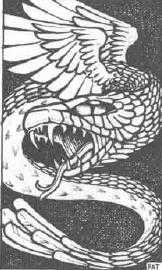Couatl
| Couatl | |
|---|---|
 | |
| Characteristics | |
| Type | Outsider |
| Image | Wizards.com image |
| Stats | Open Game License stats |
| Publication history | |
| Source books | Quetzalcoat |
In the Dungeons & Dragons fantasy roleplaying game, the couatl is a large serpentine creature, and in 3rd edition is considered a native outsider.[1]
Publication history
The name 'couatl' is a reference to Quetzalcoatl, an Aztec god, sometimes called 'The Plumed Serpent'.[citation needed] The couatl first appeared in Eldritch Wizardry supplement (1976).
The couatl appeared in first edition Advanced Dungeons & Dragons in the original Monster Manual (1977).[2]
The couatl appeared in second edition Advanced Dungeons & Dragons in Monstrous Compendium Volume One (1989),[3] reprinted in the Monstrous Manual (1993).[4]
The couatl appeared in the third edition Monster Manual (2000),[5] and the version 3.5 Monster Manual (2003).
The couatl appeared in the fourth edition Monster Manual 2 (2009).
Ecology
Couatls are known throughout the Dungeons & Dragons universe for their beauty, magic, and virtue. Because of their intelligence and devotion to good, they are worshipped by people who inhabit the same area as them.
Environment
Couatls inhabit warm jungles.
Typical physical characteristics
A couatl resembles a long, feathered serpent with a pair of rainbow-feathered wings that allow it to fly. They are around 12 feet (3.5 meters) in length, with a wingspan of 15 feet (4.5 meters). They weigh around 1,800 pounds (882 kilograms). Their powerful minds are capable of great psionic might.
Alignment
A couatl is always lawful good.
Society
Greyhawk, Forgotten Realms
Couatls live solitarily, in pairs, or in flights of 3-6 individuals.[6] Their intellect is above that of most humans, and, although they do not use weapons and armor as a human might, they often own treasure. They typically speak Common, Draconic and Celestial.
Couatls are highly dedicated to an asexual deity named Jazirian, though they have no true priests among their ranks, as Jazirian grants each couatl enough power and wisdom of their own.[7] People living in the same area as couatl recognise this, and sometimes worship them as deities. Being outsiders, they hail from another plane,[8] and can be summoned. The spell Summon Monster IX can summon a couatl.[9]
Eberron
Much as above, except that they were the principal opponents of the Rakshasa Rajahs, and most of them are now contained within the Silver Flame—or, rather, there is a universal force that binds the rajahs into the Underdark, created by the noble sacrifice of the couatls, of which the Silver Flame is only one small, local aspect.
Fourth Edition
In the "Points of Light" default setting of Dungeons & Dragons' fourth edition, Couatls live in the Astral Sea in floating cities composed of solid clouds. Their society is a meritocracy loosely patterned after Imperial China, where social advancement and the favor of their emperor are gained by destroying devils and other forces of evil. As a consequence of this, many couatls place more concern on the pursuit of status and their public image than the good their efforts may accomplish.
Couatl in other media
The couatl appears in the D&D Miniatures: Deathknell set #2 (2005).
Other games
The couatl also appears in Warcraft III: The Frozen Throne, as a unit for the Naga. It can also be encountered as a low-tier enemy in Might and Magic VIII: Day of the Destroyer.
Notes
- ↑ Couatl page from the D20 System Reference Document
- ↑ Gygax, Gary. Monster Manual (TSR, 1977)
- ↑ Cook, David, et al. Monstrous Compendium Volume One (TSR, 1989)
- ↑ Stewart, Doug, ed. Monstrous Manual (TSR, 1993)
- ↑ Williams, Skip, Jonathan Tweet, and Monte Cook. Monster Manual (Wizards of the Coast, 2000)
- ↑ Dungeons & Dragons 3.5 Edition Monster Manual
- ↑ Page from EnWorld.org about Jazirian
- ↑ Dungeons & Dragons 3.5 Edition Monster Manual
- ↑ Dungeons & Dragons 3.5 Edition Player's Handbook
| |||||||||||||||||||||||||||||||||||||||||||||||||||||||||||||||||||||||||||||||||||||||||||||||||||||||||||||||||||||||||||||||||||||||||||||||||||